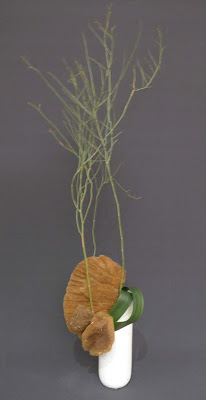Our Iemoto, Akana Teshigahara, has always encouraged teaching ikebana to children, perhaps because she was a kindergarten teacher before taking on the role of Iemoto. I would hope she would be pleased with the work that my grandchildren did.
The two photographs, below, are of an arrangement and a sketch of said arrangement by Guy Pasco. He was doing the lesson in Book 2 - 'Freestyle Arranging and Sketching'. Most ikebanist (me included) do a very rough sketch with this exercise but Guy, having studied fine arts has done a beautiful sketch.
Sadly for us, Guy has now left us but it was for the best of reasons. He has relocated up north where he was offered his dream job. We will miss him and wish him every success and happiness.

 |
| I used agave leaves and strelitzia - comparable to sculpture |
 |
| Vicky Kalokathis used contorted hazel branches with strelitzias - comparable to a painting |
 | |
|
 |
| Nicole McDonald used willow stems and tulips - comparable to music |
And now for some arrangements I did just for fun.
This next piece came about after I pruned my persimmon tree. I had one branch with three stems creating a dome shape. On its own it was too sparse to use, so I attached many other branches, more to one side than the other, thus maintaining asymmetry and added the green goddess to finish. I made the ceramic container many years ago. The design was inspired by the huge air conditioning pipes on the ceiling of the domestic terminal of the Sydney Airport.
I, absolutely, had to make an arrangement with the garrya eliptica while it is at its absolute best. The pale pink camellias (although they look white in the photo) went beautifully with the greeny-grey of the garrya. This container is also self made.
Japanese flowering quince and camellias - a match made in ikebana heaven!
The container for this little arrangement was a gift from the ladies in Wellington and I used echinops with squiggly grass that repeats the spiral on the container.
And one more thing, the Ikebana International Annual Exhibition will be on next week. The details are:
Lobby Gallery, Level 1
SOFITEL MELBOURNE ON COLLINS
25 Collins Street, Melbourne
Tuesday 24th to Sunday 29th July, 2018
Bye for now,
Emily



















